The Surface 3 Review
by Brett Howse on May 4, 2015 9:00 AM ESTSystem Performance
Since the Surface 3 is a tablet that can replace your laptop, comparisons will be made between both devices. Because the new tablet is running full Windows 8.1 x64, it is possible to run the full benchmark suite that we have for laptops. On the tablet side, there are not a lot of cross-platform benchmarks so the only thing that can really be used is browser based tests. It is not ideal, but we have to work with what we have.
To summarize the Surface 3, it is powered by the top model of the latest Intel Atom 14nm stack. The Atom x7-Z8700 is a quad-core processor with a base frequency of 1.6 GHz. The CPU can turbo up to a maximum of 2.4 GHz, and all of this is done within a 2 watt Scenario Design Power. The review unit that I received is the $499 unit, so it only has 2 GB of LPDDR3 memory rather than the 4 GB offered on the higher priced model.
For comparisons against tablets, I have selected a sampling of several devices that have already been reviewed. Some of the devices are running on ARM processors, and several of the Windows ones run on Intel Core M, with a few more running on previous Atom architectures. To compare this device against any other device we have tested, please check out our Mobile Bench.
Tablet Performance
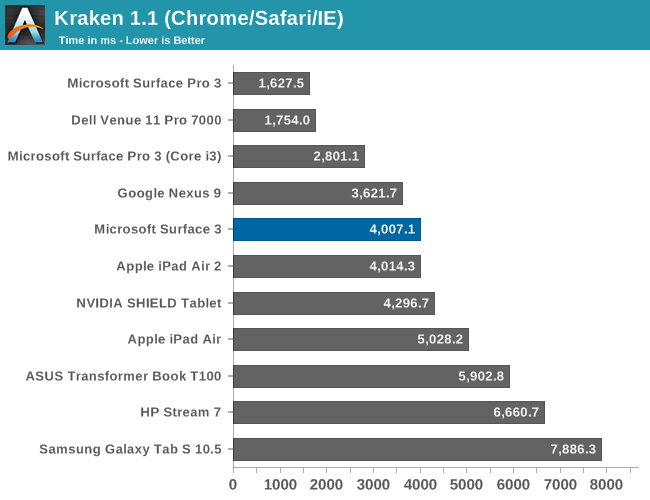
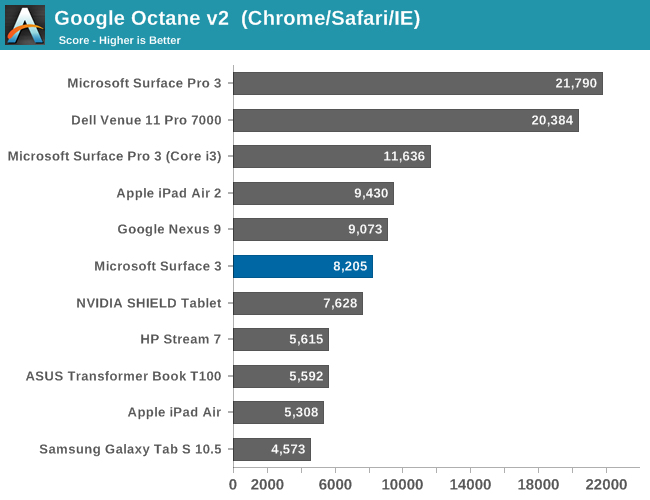

Since we just have web benchmarks to compare against other platforms, it does make it difficult to get a true feel for how Atom compares to the best, but when comparing to ARM processors it is fairly competitive. All of the web benchmarks are done using Chrome (hopefully we can switch to Microsoft Edge soon) because IE 11 has pretty awful javascript performance. Atom is a long ways off of the Core series in the Surface Pro line, and well back of the Core M powered Dell Venue 11 Pro tablet. There is a big jump in performance compared to the Bay Trail ASUS T100 and HP Stream 7. That is important since Cherry Trail is not a big architecture update, but mostly a process shrink, so the 14 nm processes can keep everything running at higher frequencies in the same power envelope.
Laptop Performance
By attaching the keyboard, the Surface 3 becomes a pretty reasonable laptop, so to see how much of a performance drop off there is with tablet class parts, the Surface 3 was run through our Laptop suite as well. The Atom is also equipped with eMMC storage, and some of the tests like PCMark take storage into account. Other benchmarks like Cinebench and x264 are CPU only. To compare the Surface 3 against any other laptop we have tested, please use our Laptop Bench.
PCMark

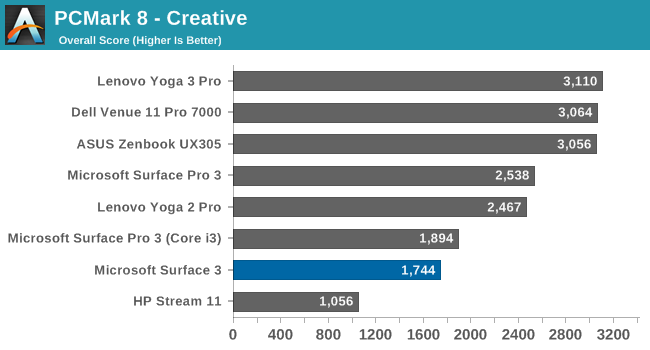
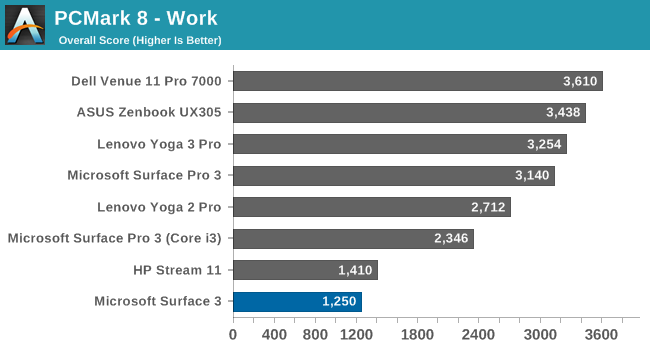
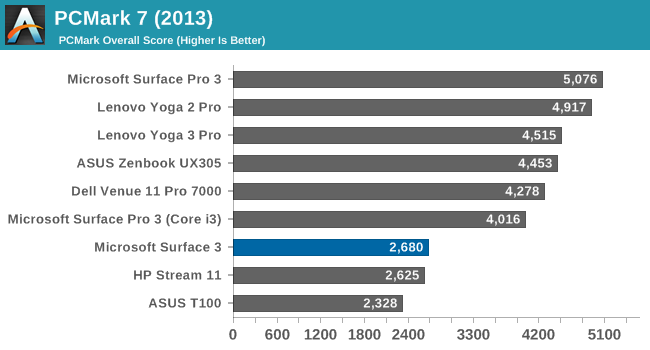
PCMark 8 from Futuremark has several benchmarks within it, all with the goal of simulating real-world use cases for each of the scenarios. It includes Home, Creative, Work, and Storage benchmarks. The workloads generally include both burst and sustained performance. The Atom can’t compete with the bigger Core pieces, but it is actually surprisingly close to the Core i3 Surface Pro 3. I think this is less about Atom and more about how handicapped Core i3 is with its lack of Turbo.
TouchXPRT


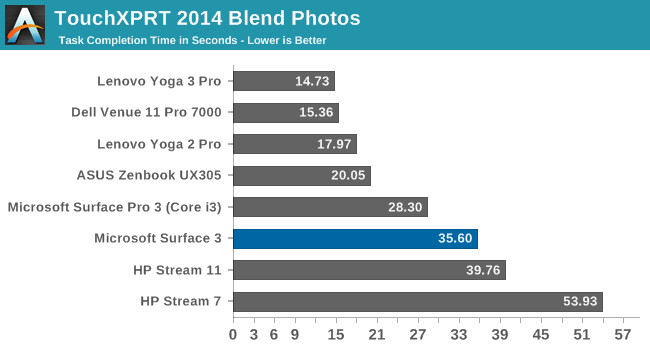
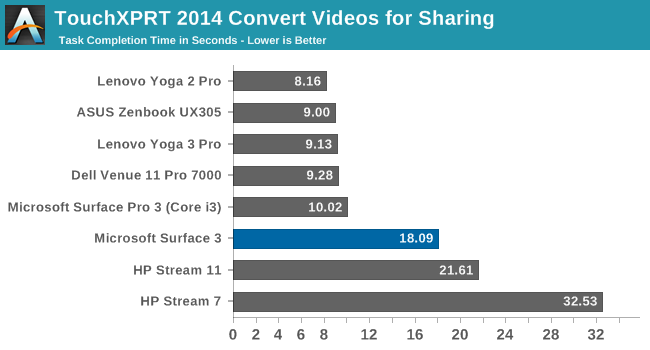
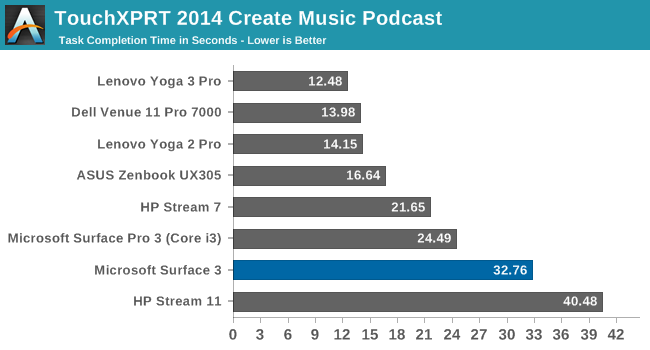
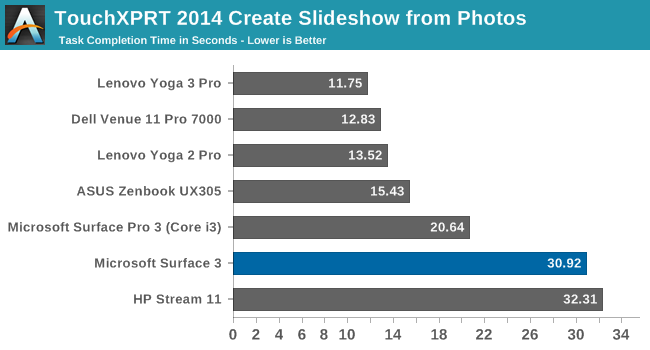
TouchXPRT 2014 is a benchmark that has a lot of burst workloads. The tasks are quick, but heavy, and it gives the processor a quick chance to cool off between each one so normally it is good about not running into throttling behaviour. The Atom processor is a long way off of the Core series here, with the exception of the i3 Surface Pro 3 which has no turbo capability. However there is a good bump in performance over the previous generation Atom in the HP Stream 7.
Cinebench

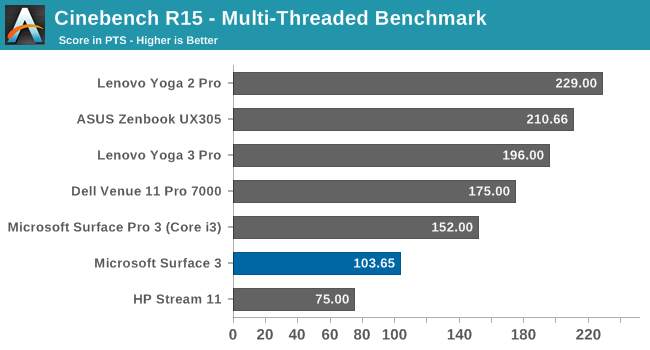
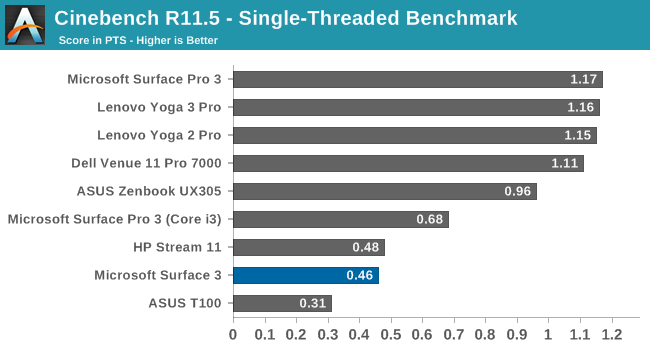
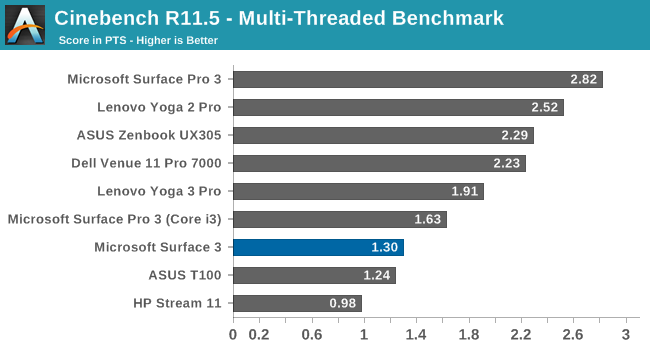
Cinebench is purely a CPU task, and it loves Instructions Per Clock (IPC) and frequency. There are two modes here with a single CPU run and all core run. It is still a long ways back of the Core i3 Surface Pro 3 on this test, and despite the Atom processor having four physical cores and the Core processors having only two physical and four logical cores, it is still not enough on the multithreaded run to really close the gap, although it does slightly. Looking at version 11.5 of this test, we have more data going back to older devices, so there are scores available from the ASUS T100 and there is a bump in performance compared to Bay Trail.
x264
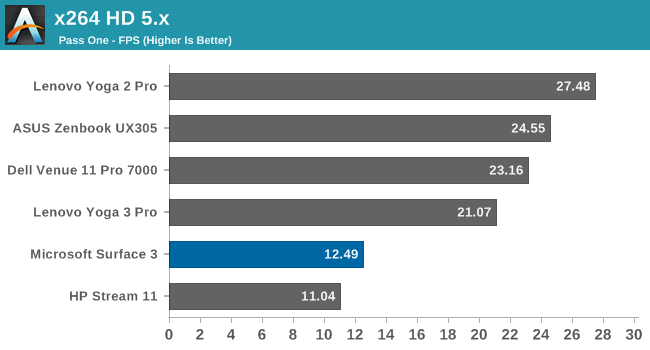

Once again this is a benchmark that prioritizes good IPC and frequency, along with multiple cores. The Atom struggles here compared to Core, which at this point should not be a surprise.
So clearly the new Cherry Trail CPU cores are not a giant leap in performance over Bay Trail, but like Haswell to Broadwell, there is a decent bump and the better manufacturing process helps increase overall performance due to the additional thermal headroom in the same power envelope. However when comparing it to the ARM competition, we only have a few data points but it does seem to be about on par with the top ARM CPUs at this time. Comparing devices across different operating systems is always difficult though.
Using the device day to day as a tablet though, performance was good. Yes, it could be better, and devices that use Core M are going to be able to run circles around Atom, but at the cost of additional heat. One of the nicest surprises of using this tablet was that it just never got warm at all, and the same cannot be said of any of the passively cooled Core M devices. Sure, when running very heavy benchmark loads, there was a bit of heat on the back, but it was never much more than around 30°C or so.
My experience was that when the Surface 3 felt slow, it was often not CPU bound but disk bound.










265 Comments
View All Comments
MrSpadge - Monday, May 4, 2015 - link
Using legacy apps (which are still called programs) should be fine with the pen. Except for the high DPI display - depending on how legacy the app exactly is.Alexvrb - Monday, May 4, 2015 - link
It runs touch-friendly modern apps (including Universal apps which will be getting a boost in the near future) as well as more traditional software. You can use just about any external accessory that you can with a regular PC. If you use the dock and a larger monitor this can even replace the desktop for many users. In many ways it is more versatile than the devices you mentioned.stephenbrooks - Saturday, May 9, 2015 - link
Actually a lot of programs designed for mouse input (click and drag) work pretty well on a touchscreen Windows machine. The main problem is the buttons tend to be too small for fingers.It would be great if Microsoft could have an option to magically enlarge GUI elements a bit when in touch mode.
jaydee - Monday, May 4, 2015 - link
When I say lack of apps, I mean as designed as portable tablet. That's what MS is touting, it's a tablet and laptop in one.Of course it has tons of apps as a Win8/10 device, but if that's all you're really after, why buy something that straddles the line between laptop and tablet? Why not an XPS 13 or Spectre x360? Proportionally few of those Windows apps tend to run real well on a 10" touch screen with a resolution of 1920x1280.
It just seems to be in an odd place. I'm not sure what it does really well, other than its display. CPU/RAM/SSD are all compromised as a laptop and it's too expensive for what it does as a tablet. It's not "bad" by any means, I really do *want* to like it, it just doesn't seem to do the laptop thing well enough, be a tablet at a low enough price point. And I'm someone who would like to replace my iPad Air with something convertible like this. But if I'm going to buy a laptop that can also be used as a tablet, it's either going to have to have higher performance, or be cheap enough to not feel bad replacing in a couple years, and I don't feel either with this (particularly with accessories). I'm much more apt to get the i5/8GB/256GB HP Spectre x360 @$1,000, while more expensive, I feel much better about thinking about using for the next 5 years, compared to the Surface $600 + type cover + dock @ $930 and still has a tablet mode. The Surface Pro 3 is nice, but I'm not sure what it offers over the Spectre x360, at a sales price of ~$1,130 (retail $1,300), not to mention being a gen behind with Haswell still. If history is any indication, I will like the SP4 as a product, but probably not at it's price point.
Impulses - Monday, May 4, 2015 - link
If the base model included 4GB and/or they at least threw in the pen for free with certain combos, it'd be more enticing. It's still an attractive package for people who just want a secondary system, but a lot of those are just gonna end up with cheaper tablets or more capable laptops.Even tho it's significantly cheaper than SP3, and it's exactly what a lot of people said the base Surface should've been all along, it still feels like less of a value proposition than SP3. Better storage and Type C might've made it more appealing...
As it is it feels too much like something they'll refine significantly for the next rev... Big EDU discounts could sway things tho. A simple $100 student discount would make it a $530-630 hybrid competing against $400-500 tablets and $750+ laptops, much better sweet spot.
simard57 - Thursday, May 7, 2015 - link
Costco has a bundle that includes keyboard and pen for $100 more over the 2GB and 4GB modelsillegaloperation - Monday, May 4, 2015 - link
How much is portability worth to you?The HP Spectre x360 weigh over twice that of the Surface 3.
Also, why is the Dock being factor into the price? The Dock is nice to have, but it's hardly essential.
The0ne - Monday, May 4, 2015 - link
Just curious, what apps are you missing one the Windows platform? For someone like me who would use this for work, I can't imagine an app that is not available that I would use. You mean it doesn't have the hundreds and thousands of useless apps that are in all markets? Always confused by this statement.jaydee - Tuesday, May 5, 2015 - link
In order for it to be considered a good "tablet", it has to do all those things that tablets are known for. Apple and Android have this tremendously large ecosystem that many people are vested in and there's a huge selection for. Obviously "entertainment" apps are going to be useless for people who use this for work. Just like the "productivity" apps aren't useful for those who use it for entertainment, etc. Certainly, the Windows tablet is a better match for a certain type of productivity user like yourself, then a gamer per se. What a tablet has come to be, for many people though is a ubiquitous device that transcends both genres and I don't see that in the Windows platform. Not to mention the fact that Apple/Android tablet users are going to have a hard time switching over if they've invested a decent amount of money into their Apple/Android apps.Like I said, I really want to like this device, but it just feels like too many compromises as a laptop and a mixed bag as a tablet. Does that mean that it's not a great device for some people? Absolutely not! I just don't see it doing one (laptop) or the other (tablet) well enough to break through mainstream and be a big seller at this price point. As other people have mentioned, if it were a lower price or included accessories or faster storage or Core-M instead of Atom were here, I would probably feel much different, but it's too many compromises as is.
Gigaplex - Monday, May 4, 2015 - link
With Windows 10, Microsoft is aiming to bridge the "App gap" by making porting of iOS and Android apps to Windows fairly trivial.